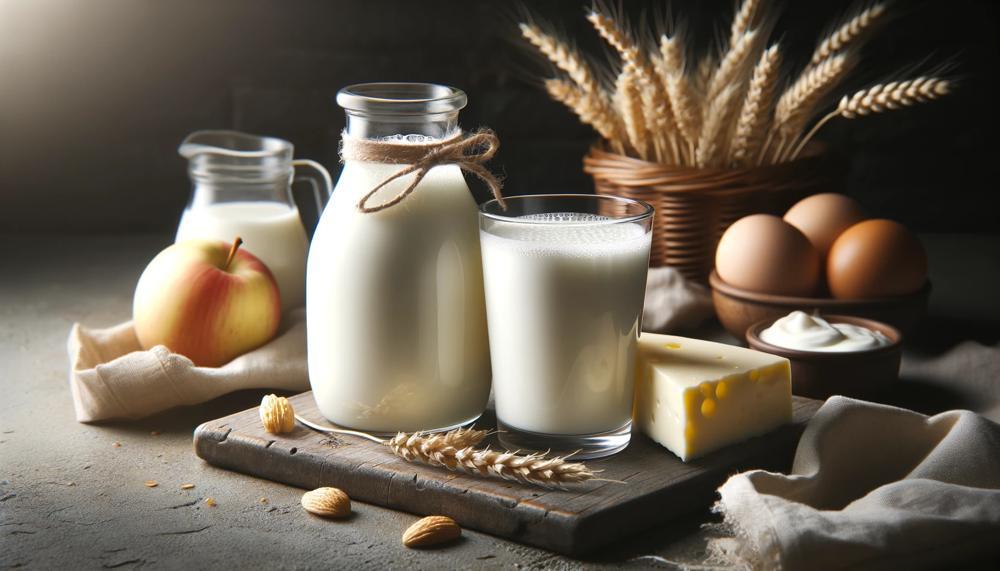Are you tired of constantly making trips to the grocery store for cooking or baking essentials? Are you looking for a way to streamline your kitchen and save money on ingredients? Buttermilk may just be the solution you’re looking for.
Buttermilk has been a go-to ingredient in kitchens for centuries, known for its tangy flavor and creamy texture. But did you know that it can also be used as a substitute for half and half in many recipes? That’s right – this versatile and affordable ingredient can work wonders in your dishes. Here’s what you need to know:
- Buttermilk has a lower fat content than half and half, making it a healthier alternative.
- Its subtle tanginess can enhance flavors in various dishes.
- Buttermilk is more budget-friendly than half and half, making it an economical choice.
- It can be incorporated into both sweet and savory recipes, from pancakes to soups.
In this blog post, we’ll delve deeper into the benefits of using buttermilk as a substitute for half and half. We’ll also share some mouthwatering recipes that will make you want to stock up on buttermilk immediately.
Get ready to elevate your cooking game with this simple yet effective swap.
Contents
- 1 The Differences Between Buttermilk and Half and Half
- 2 Can I Substitute Buttermilk for Half and Half?
- 3 How Does Substituting Affect the Recipe?
- 4 Tips for Successfully Substituting Buttermilk for Half and Half
- 5 Other Dairy Substitutes for Half and Half
- 6 Non-Dairy Options for Replacing Half and Half
- 7 When Not to Substitute: Recipes That Require Specific Dairy Products
- 8 Conclusion
The Differences Between Buttermilk and Half and Half
There are several notable distinctions between buttermilk and half and half, including their fat content, acidity levels, and consistency. Buttermilk has a lower fat content and is more acidic, while half and half is creamier with a milder flavor.
In terms of usage, buttermilk is commonly used as a marinade or in baked goods, while half and half is typically used as a creamer or topping. While they can be substituted for each other in certain situations, it’s essential to make modifications to compensate for the differences in order to achieve the desired outcome.
See the table below for a quick comparison of these two dairy products.
| Buttermilk | Half and Half | |
| Fat Content | Low (approximately 2%) | Higher (around 10%) |
| Acidity | High (tangy/sour) | Lower (mild) |
| Consistency | Thick | Creamy |
| Main Uses | Baking, marinating, dressings/dips | Creamer, topping, desserts |
| Substitution Suitability | Suitable for small amounts or in specific recipes (e.g. for acidic ingredients) | Note suitable for all recipes (e.g. creamy soups/sauces) |
| Other Dairy Substitutes | Mixtures of whole milk/heavy cream or evaporated milk. | Non-dairy alternatives include coconut cream, soy milk/coconut oil mixtures, or cashew cream. |
Can I Substitute Buttermilk for Half and Half?
Yes, it is generally safe to use buttermilk as a substitute for half and half in cooking and baking. However, it’s crucial to make adjustments to ensure the desired outcome in terms of taste and texture.
Buttermilk has a tangy flavor and thicker consistency than half and half, making it a popular choice for baking. It also has a lower fat content than half and half, making it a healthier option. On the other hand, half and half has a creamier texture and higher fat content, making it more suitable for use as a coffee creamer or in sauces and soups.
If you are substituting buttermilk for half and half in cooking or baking, it’s important to adjust the fat and acidity levels. Here is a comparison table of the two dairy products:
| Product | Amount of Fat | Level of Acidity |
| Buttermilk | 2% | High |
| Half and Half | 10-18% | Low |
As shown in the table, half and half has significantly more fat than buttermilk. To compensate for this, you may need to reduce the amount of butter or oil in your recipe when using buttermilk instead of half and half. Additionally, buttermilk has a higher acidity level than half and half, so adding some lemon juice or vinegar to your half and half may help achieve a similar level of acidity.
It’s also essential to consider the specific recipe you are using when substituting one dairy product for another. For instance, if you are making coffee creamer, replacing half and half with buttermilk may significantly change the taste and texture of your coffee. In this case, it’s best to stick to using half and half.
How Does Substituting Affect the Recipe?
When it comes to cooking, substituting ingredients can have a big impact on the final dish. This is especially true when it comes to using buttermilk instead of half and half in a recipe. The tangy and slightly sour taste of buttermilk can drastically alter the overall flavor of a dish, compared to the more neutral taste of half and half. Depending on the recipe, this change in flavor may be desirable or not.
Not only does buttermilk differ in taste, but it also has a thicker consistency than half and half. This can greatly affect the texture of the final dish. For example, if you are making a sauce or soup that requires a thicker consistency, using buttermilk instead of half and half may result in a thinner and more watery end product. However, in baked goods, the difference in texture may not be as noticeable.
Buttermilk is also a cultured dairy product, which means it contains live bacteria that interact with other ingredients in the recipe. This can lead to different chemical reactions during cooking or baking compared to using half and half.
For instance, when combined with baking soda, the acid in buttermilk creates carbon dioxide gas, which helps baked goods rise. If you use half and half instead of buttermilk, you may need to make adjustments to the amount of baking soda used or add an acidic ingredient like lemon juice or vinegar to achieve similar results.
Tips for Successfully Substituting Buttermilk for Half and Half
Successfully substituting buttermilk for half and half in recipes requires careful consideration and adjustments to ensure a successful outcome. Here are some useful tips to keep in mind:
Adjust the fat content
It’s essential to note that buttermilk and half and half have different fat contents, with buttermilk having less fat than half and half.
To compensate for this difference, you can add melted butter or oil to the recipe when using buttermilk as a substitute for half and half.
Consider acidity levels
Another crucial point to consider is that buttermilk is more acidic than half and half. Therefore, if the recipe calls for baking soda, it may need to be removed or replaced with baking powder.
You can also turn your half and half into a similar product to buttermilk by adding lemon juice or vinegar.
Make a half-and-half substitute
If you don’t have buttermilk on hand, you can create a convenient half-and-half substitute by mixing equal parts whole milk and heavy cream.

Then, you can add melted butter or margarine to get a similar consistency to buttermilk.
Avoid overmixing
When substituting buttermilk for half and half, it’s essential to be mindful of how much you mix the batter or dough.
Overmixing can result in a tougher texture due to the acid in the buttermilk activating the gluten in flour.
Consider the recipe
It’s crucial to keep in mind that buttermilk is commonly used in baking and as a marinade, while half and half is often used as a creamer or in desserts. Therefore, always consider the specific needs of your recipe before making the substitution.
Be cautious with creamy soups or sauces
In dishes where the consistency is crucial, such as creamy soups or sauces, substituting buttermilk for half and half may not be recommended.
Experiment with other substitutes
If you don’t have buttermilk or half and half on hand, don’t worry. You can use other dairy substitutes like whole milk/heavy cream mixtures or even non-dairy options like coconut cream as substitutes.
Remember to always consider the specific needs of your recipe and make adjustments accordingly when substituting buttermilk for half and half. With these tips in mind, you can successfully use buttermilk as a substitute for half and half in your favorite recipes.
Other Dairy Substitutes for Half and Half
Non-fat Milk
When it comes to substituting half and half, non-fat milk is a common choice. However, be aware that it may result in a thinner consistency and less creamy texture. To make up for the lower fat content, you can add a small amount of melted butter or heavy cream to the milk.
This will help maintain the richness and thickness of your dish.
Soy Milk
Soy milk is another popular dairy-free alternative for half and half. It has a similar consistency and can be used in equal parts as a substitute. However, keep in mind that soy milk has a distinct flavor that may alter the taste of your dish.
So, if you’re not a fan of its taste, you may want to consider other options.
Coconut Milk
For those who enjoy a creamy and rich substitute for half and half, coconut milk is a great choice. It works well in both sweet and savory dishes, but it does have a noticeable coconut flavor that may not work with all recipes.
So, if you’re not a fan of coconut, this may not be the best option for you.
Almond Milk
Almond milk is another popular dairy-free substitute for half and half. It has a slightly nutty flavor that may not be suitable for all dishes, but it is a great option for those with lactose intolerance.
Just be aware that it may result in a slightly thinner consistency compared to other substitutes.
Cashew Milk
Cashew milk is a lesser-known alternative to half and half, but it has a similar consistency and taste. It works well in both sweet and savory dishes, but it may not be as readily available as other substitutes.
So, if you’re able to find it at your local grocery store, give it a try.
Pea Protein
For those looking to avoid dairy products, pea protein is a plant-based option that can be used as a substitute for half and half. It has a thicker consistency than other substitutes, making it a good choice for creamier dishes.
Just keep in mind that it may have a slightly different taste compared to traditional half and half.
Oat Milk
Oat milk is another dairy-free option that can be used as a substitute for half and half. It has a mild flavor that won’t overpower your dish, but it may result in a thinner consistency.
So, if you’re looking for something with a more neutral taste, this may be the perfect option for you.
Store-Bought Options:
For those who prefer to use store-bought substitutes, there are several options available in most grocery stores. Some popular brands include Califia Farms Unsweetened Better Half, Silk, and Ripple.
These substitutes are specifically designed to mimic the consistency and taste of half and half, making them a convenient option for those looking to avoid dairy.
Non-Dairy Options for Replacing Half and Half
When it comes to finding a suitable replacement for half and half in your recipes, there are numerous non-dairy alternatives to consider. These options not only cater to those with dietary restrictions, but they also offer a variety of flavors and consistencies to suit different preferences. Some popular non-dairy options for replacing half and half in recipes include non-fat milk, soy milk, coconut milk, almond milk, cashew milk, pea protein, and oat milk.
Non-fat milk is a common substitute for half and half, as it has a similar consistency and is widely available. Another popular option is soy milk, which offers a similar texture and taste while also being a great source of protein. For those who prefer a creamier and richer option, coconut milk is a great choice. It can add a subtle coconut flavor to dishes and is often used in curries and soups.
Almond milk and cashew milk are also suitable substitutes for half and half in recipes. They provide a nutty flavor and can be found in both sweetened and unsweetened varieties. Pea protein is a newer addition to the non-dairy market but has gained popularity for its creamy consistency and high protein content.
If you’re looking for a convenient store-bought option, there are non-dairy alternatives to half and half available such as Califia Farms Unsweetened Better Half, Silk, and Ripple. These products mimic the taste and texture of traditional half and half, making them great for baking or adding to coffee.
Below is a table comparing the storage periods for different non-dairy options for replacing half and half in recipes:
| Non-Dairy Option | Storage Period |
| Non-fat milk | 5-7 days in the fridge |
| Soy milk | 7-10 days in the fridge |
| Coconut milk | 7-10 days in the fridge, or can be frozen |
| Almond milk | 7-10 days in the fridge, or can be frozen |
| Cashew milk | 7-10 days in the fridge, or can be frozen |
| Pea protein | 7-10 days in the fridge, or can be frozen |
| Oat milk | 7-10 days in the fridge, or can be frozen |
When Not to Substitute: Recipes That Require Specific Dairy Products
Certain recipes call for specific dairy products, such as buttermilk pancakes, creamy soups, and homemade ice cream. It is crucial to avoid substituting these ingredients because they serve distinct purposes and possess unique properties that can greatly impact the dish’s flavor and texture. Replacing one dairy product with another can lead to a disappointing or unpalatable end result.
For example, let’s take a look at buttermilk pancakes. This beloved breakfast dish relies on the tangy flavor and acidity of buttermilk to create the perfect fluffy texture. Substituting regular milk for buttermilk will not produce the same results, as milk lacks the necessary acidity to activate the leavening agents in the batter.
As a result, your pancakes may turn out dense and flat instead of light and airy.
Similarly, creamy soups often call for heavy cream, which adds a rich and velvety texture to the dish. Replacing it with a lower-fat alternative like skim milk will result in a thinner and less indulgent soup. The same goes for homemade ice cream, where using a substitute for heavy cream can lead to an icy and less creamy treat.
Also Read: Does Crushed Red Pepper Expire?
Conclusion
In conclusion, buttermilk is a versatile and cost-effective ingredient that can easily replace half and half in various recipes.
Its lower fat content and enhanced flavor make it a popular choice among home cooks. However, it’s crucial to make adjustments to account for the differences in fat and acidity levels between the two dairy products.
When substituting buttermilk for half and half, be mindful of how it may affect the final dish’s taste, texture, and chemical reactions. To successfully use buttermilk as a substitute, consider adjusting the fat content, balancing acidity levels, or creating your own homemade half-and-half alternative.
By keeping these tips in mind, you can streamline your cooking process and save money on ingredients without compromising on flavor or quality.




